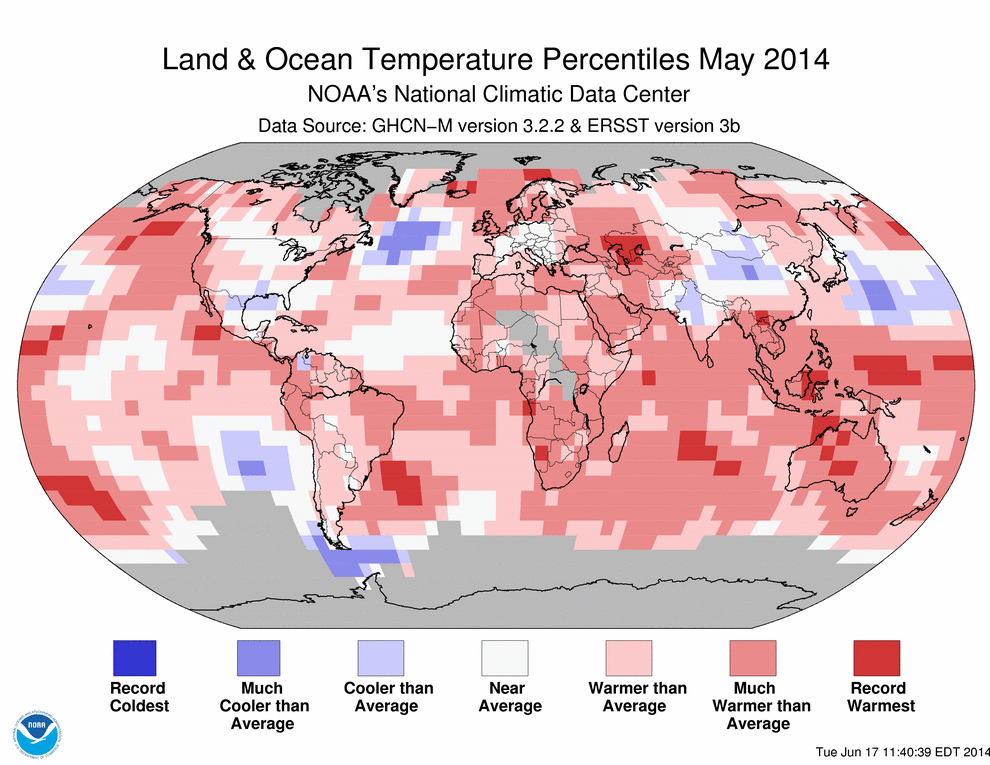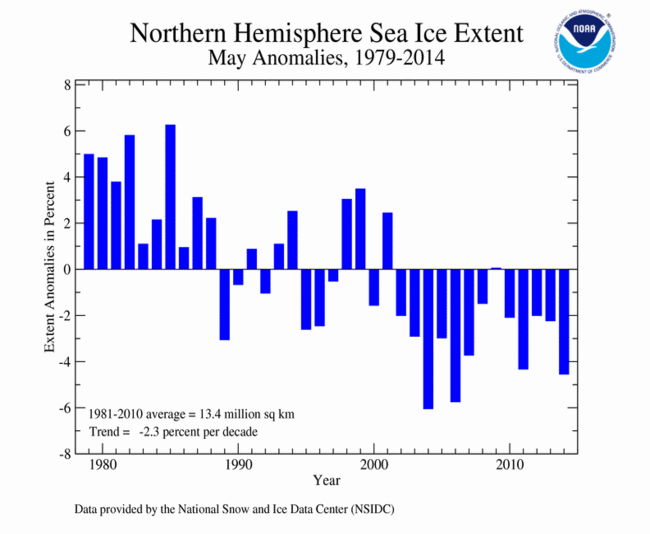Monthly Report Summary Information
The Monthly Report Summary Information is a synopsis of the collection of national and global summaries released each month.
Global Summary Information - May 2014
See Full Report
May global temperature reaches record high, driven largely by record warm oceans
Note: official monthly data for China were not received in time for inclusion in this analysis. For the purposes of this report, NCDC calculated data for China using daily reports from its GHCN-Daily dataset. When official monthly data are received from China, they will replace the NCDC calculations. The contents of this report will not be altered, but the long-term record at NCDC's Global Temperature Anomalies Page will reflect the official data.
The majority of the world experienced warmer-than-average monthly temperatures, with record warmth across eastern Kazakhstan, parts of Indonesia, and central and northwestern Australia. Scattered sections across every major ocean basin were also record warm. Part of the northeastern Atlantic, small sections of the northwestern and southeastern Pacific, and the ocean waters off the southern tip of South America were cooler or much cooler than average.
Global temperature highlights: May
- The combined average temperature over global land and ocean surfaces for May 2014 was the record highest for the month, at 59.93°F (15.54°C) or 1.33°F (0.74°C) above the 20th century average. The margin of error associated with this temperature is ±0.13°F (0.07°C).
- May marked the 39th consecutive May and 351st consecutive month with a global temperature above the 20th century average. The last below-average temperature for May occurred in 1976 and the last below-average temperature for any month occurred in February 1985.
- The global land temperature was the fourth highest for May on record, at 2.03°F (1.13°C) above the 20th century average. The margin of error is ±0.23°F (0.13°C). The Southern Hemisphere land temperature was record warm for May.
- Some national highlights are included below:
- The nationally averaged May temperature for Australia was the third highest in the country's 105-year period of record, at 2.92°F (1.62°C) above the 1961–1990 average. The average temperature for South Australia was record warm for May, surpassing the previous record set just one year ago.
- With national records extending back to 1973, the average May temperature was record high for South Korea, at 2.2°F (1.2°C) above the 1981–2010 average.
- Spain observed a May temperature 2.5°F (1.4°C) higher than the 1971–2000 average. Most of the southern half of the country was 4–5°F (2–3°C) higher than average.
- In North America, the U.S. state of Alaska had its sixth warmest May since records began in 1918, at 3.56°F (1.98°C) above the 1971–2000 average.
- For the ocean, the May global sea surface temperature was 1.06°F (0.59°C), above the 20th century average, the highest for May on record and surpasses the previous record of +1.02°F (+0.57°C) set in 1998. This also ties with June 1998, October 2003, and July 2009 as the highest departure from average for any month on record. The margin of error is ±0.07°F (0.04°C).
- Although neither El Niño nor La Niña conditions were present across the central and eastern equatorial Pacific Ocean during May 2014, NOAA's Climate Prediction Center estimates that there is about a 70 percent chance that El Niño conditions will develop during Northern Hemisphere summer and an 80 percent chance it will develop during the fall or winter.
Global temperature highlights: March–May
- Due largely to the extreme warmth during both April and May, the combined average temperature over global land and ocean surfaces for March–May was the second highest on record for this period, behind only 2010, at 1.33°F (0.74°C) above the 20th century average of 56.7°F (13.7°C). The margin of error associated with this temperature is ±0.16°F (0.09°C).
- The global land temperature was the third highest for March–May on record, at 2.27°F (1.26°C) above the 20th century average. The margin of error is ±0.31°F (0.17°C).
- Fall 2014 was the third warmest for Australia since records began in 1910, with a nationally-averaged temperature that was 2.07°F (1.15°C) above the 1961–1990 average. With the exception of the Northern Territory, every state observed average fall temperatures among their 10 warmest on record.
- In Europe, several countries observed record or near-record warm March–May temperatures. Latvia and Norway each reported record warmth for the period, while Denmark had its second warmest spring and the United Kingdom had its third warmest.
- Due in part to the record warmth during May, South Korea observed its second highest average spring temperature on record, behind only 1998. The average maximum temperature was record high for the month, while the average minimum temperature was second highest.
- For the ocean, the March–May global sea surface temperature was 0.97°F (0.54°C) above the 20th century average, also the third highest for March–May on record. The margin of error is ±0.09°F (0.05°C).
Precipitation highlights: May and March–May
- Extreme wetness was observed during May over parts of central and eastern Europe, along with small sections in both eastern and western equatorial Africa. Extreme dryness was scattered across different parts of the globe, including northern and eastern South America, parts of northern and eastern Australia, and sections of East Asia.
- Some regions in northern and eastern Austria received record monthly rainfall for May. The region north of Salzburg to Mattersburg observed 230 percent of average May precipitation, the most since records began in 1820. Several individual stations set new May precipitation records.
- Across Spain, May rainfall was just 50 percent of average, at 1.3 inches (33 mm), with parts of central and southern Spain recording less than 25 percent of their average precipitation.
- Wet weather accompanied the warmth in Norway during spring, as March–May was among the 10 wettest in the country's 115-year period of record. Some stations in northern Norway reported more than 200 percent of average precipitation for the season.
Snow and ice highlights: May and March–May
- According to NOAA data analyzed by the Rutgers Global Snow Lab, the Northern Hemisphere snow cover extent for May was the sixth smallest in the 48-year period of record at 6.6 million square miles, which was 0.8 million square miles below the 1981–2010 average. Eurasian snow cover extent was also the sixth smallest on record for May, while the North American snow cover extent was the 12th smallest on record.
- The spring snow cover extent for the Northern Hemisphere was 10.8 million square miles, which was 0.7 million square miles below the 1981–2010 average and the third smallest spring snow cover extent on record for the Northern Hemisphere. The Eurasian spring snow cover extent was the second smallest on record, behind 2008, while the North American spring snow cover extent was the 20th largest.
- The average Arctic sea ice extent for May was 4.9 million square miles, 240,000 square miles (4.6 percent) below the 1981–2010 average, resulting in the third smallest May extent since records began in 1979, behind May 2004 and 2006, according to the National Snow and Ice Data Center.
- On the opposite pole, the Antarctic sea ice extent for May was 4.6 million square miles, 470,000 square miles (11.5 percent) above the 1981–2010 average. This marked the largest May Antarctic sea ice extent since records began in 1979, surpassing by about 140,000 square miles the previous record large May Antarctic sea ice extent that occurred in 2000. Much of the above-average ice extent occurred in the Weddell Sea off the West Antarctic coast, with above-average sea ice in nearly every region. Six of the past 12 months have had record large Antarctic sea ice extent.
- Combining the Arctic and Antarctic sea ice, May global sea ice was 9.6 million square miles, 2.6 percent above the 1981–2010 average. This was the sixth largest global May sea ice extent on record.
Global temperature highlights: January–May
- The combined average temperature over global land and ocean surfaces for January–May was the fifth warmest such period on record, at 1.19°F (0.66°C) above the 20th century average of 55.5°F (13.1°C). The margin of error associated with this temperature is ±0.18°F (0.19°C).
- The January–May worldwide land surface temperature was 1.91°F (1.06°C) above the 20th century average, the fifth warmest such period on record. The margin of error is ±0.41°F (0.23°C).
- The global sea surface temperature for the year to date was 0.92°F (0.51°C) above the 20th century average, the third warmest such period on record. The margin of error is ±0.09°F (0.05°C).
 NOAA's National Centers for Environmental Information
NOAA's National Centers for Environmental Information



